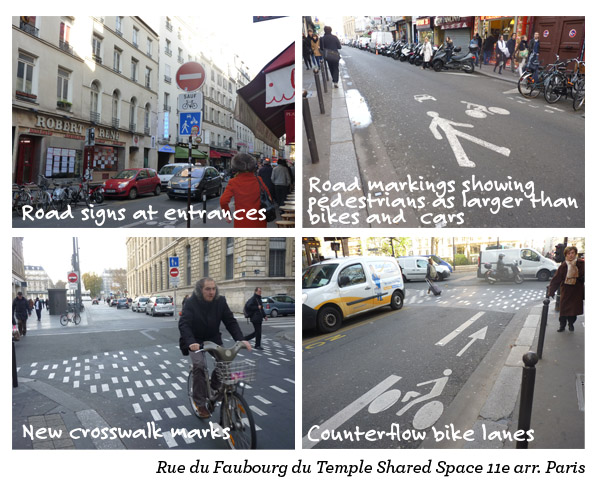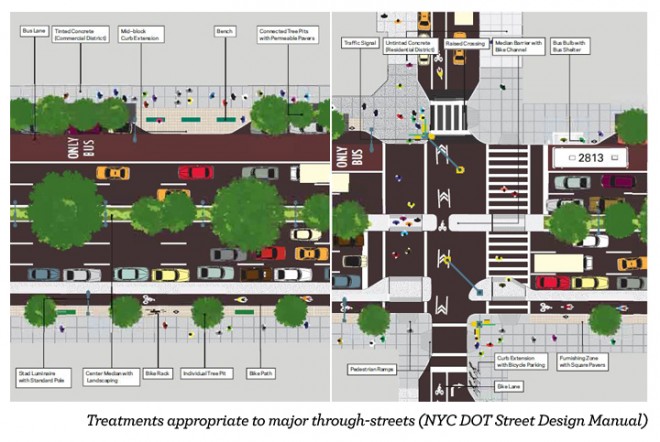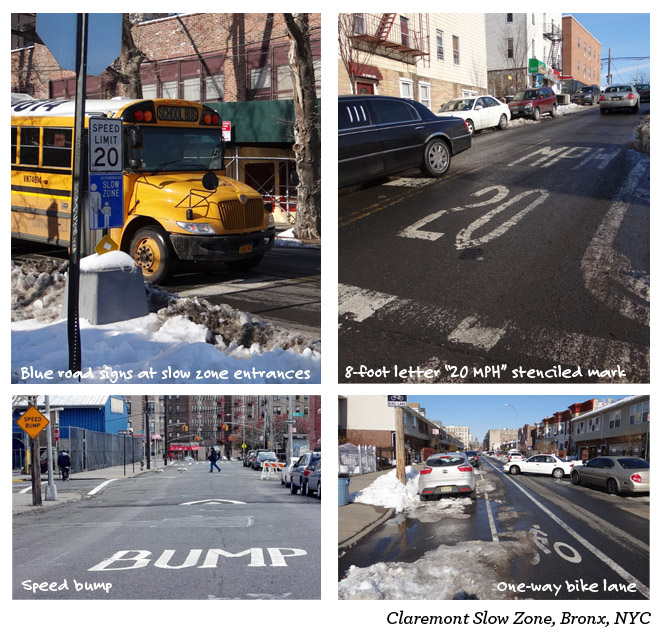A biweekly newsletter with public space news, resources, and opportunities.
A curated dispatch on all things public markets plus the latest announcements from the Market Cities Program.
Every day, high-density global cities are home to millions of pedestrians in their streets. Paradoxically though, many streets and transportation policies have placed more space and importance on cars rather than people.
In Paris, where I hail from, 60% of journeys are by foot - far beyond car trips (7%) - and 60% of Parisians do not own a car[1]. In the heart of New York City, 53%[2] of those who live and work in Manhattan never use a car, bus, subway or train in their everyday trips but instead walk, ride a bicycle or motorcycle, take a taxicab, or work at home. Not to mention the large and increasing number of tourists visiting the city (more than 50 million people yearly in 2011[3]), who widely enjoy Manhattan on foot.
At a larger scale, the metropolitan regions of Paris and New York City both show significant pedestrian mode shares. New York City has a pedestrian mode share of 34% for all trips citywide ahead of car (33%) and transit (30%)[4] when the Ile-de-France region has a weekday pedestrian mode share of 32%, a car mode share of 43%, and a public transport one up to 21%[5].
Having experienced this for myself in both cities, I decided to compare the two: How do they support this large pedestrian population and decrease auto-dominance in public space?

Since the first election of the recently replaced mayor of Paris Bertrand Delanoë in 2001, the city has been fully committed to a reduction of exclusive car-allocated public spaces in Paris. It appears as though Paris has dreamed of becoming a pedestrian city. Starting in 2012, the municipal program Pedestrian Paris Initiative has been aimed at shifting the focus from other modes of transportation to pedestrians in order to enhance sustainable mobility as a way to experience the city.
Make the streets convenient for active transportation
To facilitate pedestrian trips, Paris is radically clearing sidewalks from any obstacles. Walking gets smoother as the easiest way to move through the city, like it was before cars blocked our streets. Thus, the Pedestrian Paris Initiative is changing Paris streets by freeing and widening sidewalks. The commitment to make the pedestrian travel experience as convenient as possible can lead to a notable reduction of informal activities like outdoor displays or terraces. However, some amenities cleared off from the sidewalks are relocated on former parking strips. To enhance even more street activities and uses, the reuse of some parking spaces gave the opportunity to add amenities openly requested by Parisians such as café terraces, benches, greenery, fountains, or bike racks. This form of Placemaking makes for an even more comfortable pedestrian experience.

The municipal government has also focused on creating a balance in the street between motorized vehicles, public transportation, bikes, and pedestrians, in part by implementing lower speed limit areas. Paris has expanded the 20 miles per hour speed limit policy along with areas labeled as 12 miles per hour where pedestrians dominate the street. Once all projects are completed, 37% of Paris streets will have a speed limit under or equal to 20 miles per hour. In calming down car traffic, the city aims to make streets more welcoming for slower and more sustainable users like pedestrians and people on bikes. In addition to increasing traffic-safety, lower speeds foster the opportunity to give more and specific rights for bicyclists to support and promote travelling by bike. Where the speed limit is less than 20 miles per hour (unless stated otherwise) people on bikes can turn right at red traffic lights and benefit from counter flow bike lanes where indicated.

Streets as places to share
Besides the goal of facilitating active transportation, the city of Paris is ambitiously creating and expanding shared spaces as streets that do more than just circulate traffic. These are spaces where you can experience the urban environment.
During its last years at the head of the city, the municipal government under Bertrand Delanoë had initiated 36 shared spaces. An ambitious and recent speed up in this development since 2013 reveals a stronger and larger interest in changing Paris streets. Between 2008 (creation of the shared space legal status in France) and 2012, 13 shared spaces had been implemented in Paris whereas since 2013, a street-sharing action plan has created 23 new shared spaces in addition to the existing ones.
Here at Project for Public Spaces, we believe that there is no pure shared space but theory and practice create a continuum of streets and public spaces which help emphasize the role of active transportation and street activities. In the case of Paris, shared spaces are described as streets opened to any modes of transportation under a 12 miles per hour speed limit where pedestrians have priority over all other users. Pedestrians can walk through the street (though cannot stand) and bicyclists benefit from the new street rights at crossroads and in one-way streets. The absence of formal infrastructure is characteristic of those shared street redesigns in Paris. No costly investment is needed; the city improves pathways and sidewalks to make them continuous and smooth and adds creative road marks and signs. Only in some areas - generally located adjacent to larger urban renewal projects - demarcation between former single user-dedicated spaces is removed and black asphalt is replaced with new materials.
However, economic constraints are definitely an issue for public budgets nowadays in France. As a consequence, Paris is working on new strategies to make the streets more shareable with no significant investment in infrastructure. The city is experimenting with five kinds of crosswalk markings at the entrances and within Paris shared spaces. Displayed in different neighborhoods, Paris is meanwhile conducting an online survey to ask Parisians the type of crossroad they consider most efficient to help change mobility practices and behaviors. The city's intention is to progressively change the atmosphere of those shared spaces to make the street more welcoming to pedestrians, even when walking in the middle of the pavement.

Paris creates shared spaces in diverse areas, from touristic, commercial, and cultural places welcoming daily pedestrian crowds to more residential neighborhoods where sidewalks are too small and pedestrians are often forced to walk on the pavement. Shared spaces are usually located among 20 miles per hour areas which are covering more and more Paris neighborhoods. In the first case, the shared spaces mainly regulate and formalize pedestrian and bicyclist practices already in place (jaywalkers are not a concern anymore as people are allowed to move throughout the street as they wish). The medieval construction of Paris streets has historically made a large number of narrow and sinuous streets function like shared spaces for ages. In the second type of space, traffic safety is the main reason to implement a shared space. However, the absence of infrastructure construction to redesign the street is lacking the means to fully calm down car traffic. As car drivers see only 10%[6] of road signs because of the profusion of information in dense areas, it seems that Paris is need of finding new means to improve those places’ visibility and change driver’s behavior with its experimentation of new crosswalk markings.
However, the historic streetscape of Paris and the lack of efficiency of some existing shared spaces located on dangerous streets make us reconsider what part of the 37% of Paris streets under a speed limit of 20 miles per hour have really been improved by the recent projects. It would be prudent to quantify how shared spaces in Paris have really improved the existing streets for pedestrians.
Under the last municipal government (Mayor Bloomberg, 2002-2013), the city of New York has initiated street redesign projects to develop a network of great streets. With multiple goals such as cutting annual traffic fatalities, treating streets as public spaces, increasing bicycle commuting, and implementing a system of rapid bus lines, many of those transportation projects can be described as a quick-action approach using paint and temporary materials (in opposition to traditional construction methods) to implement complete streets. The transformation of the mostly car-oriented thoroughfares by giving a space to every mode of transportation has succeeded at improving mobility, travel opportunities, and sustainability, while reducing injuries in NYC streets. They have also been integrated with new public spaces for pedestrians and bicyclists, heavily demanded by New Yorkers.

A balance between modes of transportation and users towards world class streets
After being called a “city without seats” in a 2008 report by urban design experts engaged by NYCDOT, the city has fervently focused on public space projects to activate and create places which can be considered as infamously vibrant. NYC DOT defined long-term planning strategies and short-term actions published in 2008 in the report called World Class Streets: Remaking New York City’s Public Realm.
New York City has worked on an ambitious reallocation of space between modes of transportation. While an overall reduction of moving car traffic is not mentioned, New York City has implemented complete-streets roadway design that accommodates all users: pedestrians, people on bikes, and drivers. The reallocation of space is mainly done with painting on the pavement, allowing pedestrian plazas to be built in one weekend (Pearl St plaza in Dumbo, Brooklyn, 2007). However, it responds to design guidelines gathered in the Street Design Manual NYC DOT released in 2009. This report of more than 200 pages gives detailed instructions and guidelines on geometry, materials, lighting and furniture for safer roadways, lanes, sidewalks, plazas, etc. These transportation engineering streetscape designs have considerably enabled public realm activation and users to feel more comfortable in the streets.

The 59 small and large public plazas created by NYC DOT since 2007 are great showcases of street redesign that enable public and economic activities. After applications from local communities, NYC DOT works together with them to create temporary to permanent public plazas using spaces formerly dedicated only to motorized vehicles. Those outdoor places offer spaces to stay for New Yorkers welcoming them with colorful movable tables and chairs, sunshades in summer, and greenery. Post-project surveys show the plazas are mainly supported by New Yorkers (up to 72%[7]) and 76% of New Yorkers live now within ten minutes of open space (up from 70 in 2007[8]). Moreover, the improvements generally resulted in an increase in retail sales at locally-based businesses; like in Pearl Street in Brooklyn where local retail sales have increased by 172%, compared to 18% borough-wide[9].

Furthermore, extensive changes along Broadway beginning in 2008 were extremely ambitious. They not only created great public spaces but ameliorated traffic free flow in Times, Herald, and Madison Squares. It reallocated spaces to pedestrians and people on bikes with public seating and bike lanes. It was astonishing how the reallocation of 2.5 acres of car lanes into new pedestrian spaces with temporary materials received a very high success rate with a spike in people attracted to the place and positive outcomes for all New Yorkers. Pedestrian injuries went down by 35%, travel times improved up to 17%, five new flagship stores were opened, and retail rents doubled.
Additionally, to even more underscore NYC DOT's short-term achievements, we can mention the implementation of temporary events (Summer Streets on Park Avenue as an example) and art installations to change how pedestrians feel and use public spaces. Streets with proximity to outdoor activity creates atmospheres welcoming to pedestrians who are then able to shape these vibrant places through cultural, social, and commercial exchanges.
Safety as an emerging independent focus
In addition to the unwelcoming public places NYC has along its major thoroughfares, it seems the city has also been facing an urgent situation regarding traffic injuries in its streets. In Paris and New York City, pedestrians approximately represent half of people killed in traffic accidents. However, the average figures for 2011 and 2012 show that Paris suffered from 20 killed people per year per million of inhabitants whereas the number reached 32 in New York City. Regarding injured people, there were 3,640 people injured in Paris streets per year per million of inhabitants and 8,130 in New York City [10].
The creation of complete streets with more pedestrian-dedicated spaces and bike lanes has achieved an important reduction of annual traffic fatalities never seen in the streets before. Indeed, for instance, the public plazas allow pedestrians to find refuges in the streets making crosswalks even safer for vulnerable users. Because complete street redesign improvements narrow the moving and parking lane width, stencil high-visibility crosswalks and markings to indicate spaces dedicated to buses and cyclists, it greatly reduces the driver's desire for speed formerly given by wide lanes with minimal markings in large and straight streets.
The post-project data show positive outcomes concerning traffic safety. According to NYC DOT's outcome report on recent transportation projects released in fall 2013 (Sustainable Streets: 2013 and Beyond), the complete street redesign demonstrates safety benefits within months. At locations where major engineering changes have been made (from intersection simplification to raised medians or refuge islands), fatalities decreased by 34% since 2005. On Manhattan’s 9th Avenue, DOT installed the first on-street protected bicycle path in 2007. On this avenue, crashes with injuries dropped by 43% in the three years after implementation compared to the three years prior to the project. Cyclist volumes increased by 63% since 2007 on 9th Avenue but injuries to people on bikes are 36% less frequent than before the creation of the bike lane.
However, if traffic safety was considered as a part of a larger goal towards world class streets at the beginning of Mayor Bloomberg's mandate, it looks like it has become a topic in itself and one of the first motivations and missions for NYC DOT. Major municipal programs have recently focused on safety for vulnerable users: The New York City Pedestrian Safety Study & Action Plan (released in 2010 by Bloomberg municipality) and the current Mayor De Blasio's Vision Zero program launched during the municipal campaign and currently being implemented. The street redesign engaged by New York City Department of Transportation is getting more and more safety-focused; and the cause is considerably supported by New Yorkers who share their fears to use the streets as a pedestrian or a bicyclist.
In addition, these infrastructure works come with analytic, engineering and regulatory tools, revealing the strong motivation of NYC DOT to decrease the number of fatalities. Technology and regulations have helped street redesign and police traffic law enforcement to make New York City streets safer. For instance, NYC DOT is progressively creating school speed zones and neighborhood slow zones. The Neighborhood Slow Zone Program reduces the speed limit from 30 to 20 miles per hour and adds safety measures within residential areas. It concerns no major streets or commercial areas but instead those that suffer from major traffic crashes. In the first phase, 15 slow zones were implemented in New York City. Among the 15 2013-selected zones, Alphabet City and West Village are located in the heart of Manhattan while the other ones are in quieter neighborhoods.

Several reasons could explain the emergence of safe streets as a goal in itself in NYC transportation policies from the important positive outcomes of complete street redesign on injuries to the public support. Even though the safety concern is a major issue in any urban area, and above all in NYC where fatalities are still too high, we should also push the larger ambition to create great streets as places that function as public spaces rather than implementing safe streets through engineering streetscape improvements only.
This comparative glimpse of New York City and Paris transportation and public spaces policies, strategies and actions show that there is no a priori solution to deal with sustainable mobility for our cities. Some actions and policies overlap between both cities but a real focus on context is necessary to define what is replicable and what needs to be adapted to suit foreign situations.
What are the messages the two cities want to deliver about their public realm?
As a consequence, it looks like New York City and Paris have both taken a turn towards a drastic reduction of auto-dominance in public space. However, as the strategies and initial priorities implemented differ, the short-term consequences can be disperate. One the one hand, a complete street has fast positive outcomes in terms of crash injuries whereas a shared space with no infrastructure transformation in a residential environment will not show traffic behavior change within months. On the other hand, the separation between modes of transportation through dedicated spaces will not directly trigger a change in mobility and social behavior between street users in urban areas. Could we assume that streets where users acknowledge each other are the key to creating the richest social, economic and cultural exchanges necessary to our world class cities? I really believe that finding a balance between traffic safety and public space activation is not an easy question, but for sure both need to be undertaken jointly to improve our streets!

PPS Intern Clémence Morlet is a planner and transportation engineer recently graduated from the Ecole des Ponts in Paris where she studied and worked on transportation projects in the Paris region including the Grand Paris Express subway lines and bus rapid transit systems. For more on Paris politics and our history with the city, see this article by Stephane Kirkland.
References:
[1] City of Paris website, http://www.paris.fr/pratique/deplacements-voirie/la-rue-en-partage/la-rue-on-partage/rub_10228_stand_129382_port_25784
[2] Modal split by borough for NYC residents in Peripheral Travel Study, NYC Department of City Planning, Transportation Division, June 2010.
[3] NYC Statistics, nycgo.com
[4] Sustainable Streets Index 2008, NYC DOT, 2008.
[5] Ile-de-France Observations et Statistiques, La Revue, Décembre 2010.
[6] http://rue89.nouvelobs.com/2013/09/12/quest-cest-nouveaux-passages-pietons-245573
[7] NYC DOT, Sustainable Streets: 2013 and Beyond, 2013.
[8] City of New York, PlaNYC, Progress report 2012, A greener, greater New York, 2012.
[9] NYC DOT, Sustainable Streets: 2013 and Beyond, 2013.
[10] Author’s statistics based on the City of Paris website and French national road safety reports, New York State Department of Motor Vehicles reports (Summary of NYC Motor Vehicle Crashes)
The rich text element allows you to create and format headings, paragraphs, blockquotes, images, and video all in one place instead of having to add and format them individually. Just double-click and easily create content.
The rich text element allows you to create and format headings, paragraphs, blockquotes, images, and video all in one place instead of having to add and format them individually. Just double-click and easily create content.
Body Text Body Link
The rich text element allows you to create and format headings, paragraphs, blockquotes, images, and video all in one place instead of having to add and format them individually. Just double-click and easily create content.
Here is some highlighted text from the article.




Headings, paragraphs, blockquotes, figures, images, and figure captions can all be styled after a class is added to the rich text element using the "When inside of" nested selector system.
Headings, paragraphs, blockquotes, figures, images, and figure captions can all be styled after a class is added to the rich text element using the "When inside of" nested selector system.
Headings, paragraphs, blockquotes, figures, images, and figure captions can all be styled after a class is added to the rich text element using the "When inside of" nested selector system.